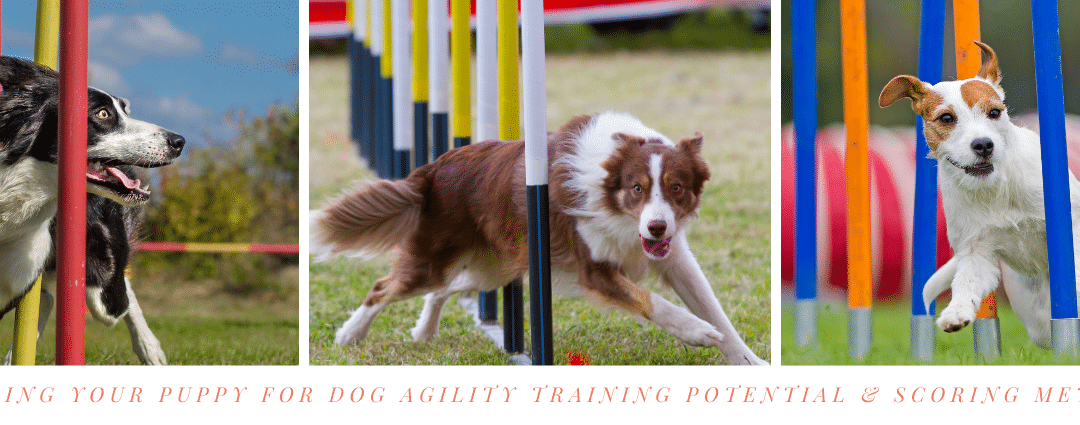Assessing Your Puppy for Dog Agility Training Potential
Not all dog owners will find that the particular breed they’re raising is suitable for dog agility training. Sometimes it’s the breed, but other times it’s the puppy itself who must be assessed for agility potential.
Each puppy will have a different temperament within the litter. If you’re considering purchasing a puppy based on its ability to train for agility, then you’ll want to do more than focus on one puppy test.
It often takes multiple tests to determine if a puppy has it in him to succeed with agility training. Not only can a one-time test mislead you into believing a puppy does not have what it takes to train successfully, but sometimes a puppy will display a characteristic one day that makes you feel he would adapt well to training, and yet it never surfaces again.
Testing for a puppy’s agility training potential has to be carried out by a trained professional who is experienced in this field. A professional will understand how to truly assess an entire litter equally.
That means giving each one the same chance to perform based on alertness, exact testing areas, hunger, and more. You can’t take one puppy who has just woken up from a nap and been fed test against a sleepy puppy who’s hungry because the attention of each dog will be vastly different.
how to teach your dog agility
It’s best if the person giving you an assessment of your puppy’s potential for agility training is the same one raising the dogs on a daily basis. This gives the breeder an edge in seeing how the puppies’ personalities develop.
If you are the one raising a litter and want to pick out a puppy for agility training, watch their routines for signs of their potential. If there always one puppy who’s first in line for everything – the food or water bowl, the door to go outside, or the chance to get some attention from its handler.
You’ll want to choose a puppy that submits to your commands easily and doesn’t fight back or make it difficult during grooming sessions. These are the best puppy tests to determine if your little dog has it in him to continue agility training.
Other factors you’ll want to consider are how well the puppy jumps since jumping is a key factor in agility training. You can look to the puppy’s parents for signs of whether this dog will handle jumping easily. Overall observation during a period of time longer than one session is required to determine is a puppy is suitable for agility training.
Agility Scoring Methods

When you participate in the sport of dog agility, chances are you’ll begin by joining a local group and handling your dog on a local course. But eventually, you may want to enter the world of master tournaments, such as the United States Dog Agility Association.
When it comes to scoring a professional trial for a dog agility competition, there are three basic ways the performance can be scored – standard scoring, time-plus-faults scoring, and points-based scoring.
With standard scoring, the dog and handler are judged against the STC, or Standard Course Time that is pre-determined by a judge overseeing the agility competition. The exact time will be set according to the level of the competition, depending on if it’s a starter, advanced, or master’s trial.
In standard scoring with dog agility competitions, faults have still assessed a penalty. The winner is whoever has the shortest period of time with the fewest penalties. If there’s a tie, then the fastest time wins.
How to get into dog agility
Time-plus-faults scoring is determined by speed. The score of the handler and dog in the agility competition is calculated by the actual time on the course plus penalties. So if the time score was 38.27 seconds on the course, but the dog incurred 9 penalties, then the score would be 47.27 seconds.
In this case, the winner of the dog agility competition is whichever dog has the lowest score overall. If a tie erupts, then a jump-off is used to determine the winner. The last scoring choice is points-based scoring.
With points-based scoring in dog agility competitions, the winner is determined according to gamblers, snooker, and other classes. Judges assign values to a certain obstacle, and each performance has a time requirement.
The points are accumulated throughout the obstacle course. If the dog achieves something, such as no faults, then he is given extra points for his performance in the dog agility competition.
With points-based scoring, the highest points-earner is the winner. Ties are broken using the fastest time as the key to winning the competition. As you go from beginner or starter status to masters-level champion, you’ll pick up the rules for each organization along the way.
To buy products visit Amazon.com for the best price and the best information and real customer review.People also ask
what is dog agility training
what makes a good agility dog
what age to start dog agility training
what obstacles are in a dog agility course
what dog breed is best for agility
what is the best agility dog
what are dog agility classes
what equipment is used in dog agility


